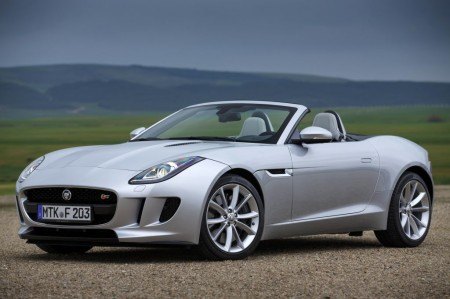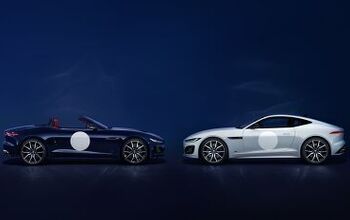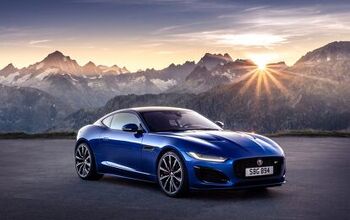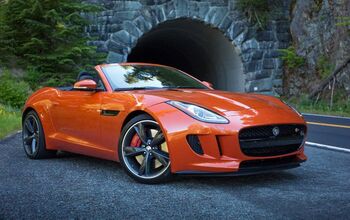2013 Jaguar F-Type Review
More than 50 years after the E-Type was launched, Jaguar has brought its successor, the F-Type to the market. You might wonder why such a long gap between both the cars. Well, the British automaker was developing the F-Type way back in the 1980s but the project was delayed time and again, finally being cancelled after Ford bought the company. In 2000, Jaguar showcased the F-Type concept but that too did not make it to production. Now the F-Type is finally on sale and is offered with an option of 3 engines, the base V6, mid level V6 S and top end V8 S. The F-Type is priced right between the Porsche Boxster and Porsche 911 Carrera, thereby sitting in no man’s land.
The styling of the F-Type is gorgeous. While it may not be a design breakthrough like the E-Type, the exteriors are very attractive and draw a lot of eye candy. The highlight at the front is the large grille with chrome lining and big air vents on either side of the bumper. There are some E-Type cues too but not very excessive. The door handles pop out of the doors when you need them, this helps the vehicle to remain aerodynamic.
The rear of the F-Type is by far the most attractive part of the car. The rear is simple, minimalistic yet so visually pleasing. The small tail lights give an E-Type deja vu, while the rear stance is extremely sporty with twin centre tail pipes on the V6 models and quad pipes (two on either side) on the V8 model sitting on the rear bumper. The rear spoiler electronically retracts at speeds over 95 km/hr and generates 120 kgs of downforce. It stays closed otherwise to keep the lines at the rear clean.
The interiors of the F-Type are a mix of sporty and luxury. The cabin is very well laid out and features excellent quality all around. You sit low but the seats are extremely supportive offering tremendous comfort. The centre console borrows some cues from the E-Type like the AC switches which take inspiration from aircraft switches. There is a grab handle for the co-driver on the centre console, it does look a bit out of place. The steering wheel feels nice to hold and the dashboard has been designed keeping the driver in mind, as every control falls into the hands of the driver easily. Being a Jaguar, there has to be some gimmick, like the centre AC vents which rise up when you turn on the air-conditioner.
The F-Type is powered by three engines. The 3.0-litre V6 produces 340 PS of power and 450 Nm of torque. This engine offers good performance even though it is the base variant. Zero to 60 mph takes 5.1 seconds, top speed and top speed is limited to 161 mph. The V6 motor is quite driveable and power delivery is linear. The V6 S engine gets an additional 40 horses and 10 Nm of torque, reducing the 0-60 sprint to 4.8 seconds. Top speed gained 10 mph.
The V6 S engine has the best balance of performance and dynamics. It has 50:50 weight distribution and both V6 S and V8 S models get active exhaust note, which amplifies the sound with a touch of a button. The V6 S feels much faster than the additional 40 horses would suggest. It pulls quickly to high speeds and even manages to offer good in-gear acceleration times. A drive around the Navarra Circuit in Spain clearly showed the good balance of the F-Type, it turns in eagerly and the steering wheel is a delight, offering tremendous feedback. There is slight bit of understeer, but very negligible.
The top end variant is the V8 S which gets the fire breathing 5.0-litre Supercharged V8 engine, producing 495 PS of power and 625 Nm of torque. This engine takes just 4.2 seconds to nudge past 60 mph from zero and has a top speed limited to 186 mph. In terms of performance, the V8 S F-Type is the quickest and feels terrifically fast with an exhaust note to match. The quad pipes emit pure melody and there are cracks, burbles and the likes every time you down shift. Step on the accelerator pedal and the F-Type responds immediately, pulling quickly to high triple digit speeds with furore. It simply feels quicker than it actually is.
However the heavier engine means the V8 S equipped F-Type is not as nimble. This model has 51:49 weight distribution and doesn’t glide through corners like the V6 S. The handling is good and so is the steering but the F-Type is not an all out track car. The Porsche 911 Carrera is more track focused. The F-Type weighs a good 150 kgs more than the Porsche and those motors handling the door and AC vent pop out mechanism add to the unnecessary weight of the car. Jaguar says the F-Type is 6% bigger than the Porsche while weighing 3-4% more. It is however unfair to compare the Jag with the Porsche, as the F-Type is an all new car, while Porsche has been tweaking and bettering the same car for 50 years now.
Mated to all engines is a 8-speed automatic gearbox which is quick with shifts and is very refined too. One can manually change gears through the SportShift gear lever (no rotary knob here) or steering mounted paddle shifts. In Sports mode, the gearbox won’t upshift and will hold the gear till you manually change-up. In Dynamic mode, the F-Type becomes more eager with better acceleration, more weight on the steering and faster shifts. The suspension too becomes stiffer and all that contributes to the vehicle offering more driver oriented performance. There is even a launch control mode, which reduces traction control to facilitate maximum acceleration. All this works very well and transforms the F-Type in a very fun to drive car. There is even a Configurable Dynamics option which lets you tweak throttle response and steering weight. You can also time your lap and measure G-forces, quite Nissan GT-R like.
The brakes on the F-Type are fabulous, they shed speeds at an instant. Pedal feel is splendid too and in spite of heavy braking on the circuit, there was very little signs of brake fade (almost negligible). Ride quality is surprising good and despite those low profile rubber, the F-Type absorbs bumps with authority, transferring very little to the occupants. The car remains glued to the road at high speeds and even with the roof down, it never feels affected by the wind.
The roof comes down in 12 seconds and the use of a soft top helps in reducing weight and bettering packaging. A wind deflector should be offered as an option. The boot is small at 200.5-litres but can swallow a golf bag. It is also bigger than most of its rivals.
The Jaguar F-Type has quite a lot to offer the sports car buyer. It looks really smashing in flesh and has interiors which are comfortable and feature rich. The ride quality is excellent and so are the brakes. All engines offer very good performance and offer a smashing exhaust note, which is reason enough to buy the F-Type. The vehicle handles well, it jinks into corners with good precision. Although the F-Type is not as track focused as its chief rival, the vehicle does offer a fun experience behind the wheel which makes it so desirable.
Faisal Ali Khan is the editor of MotorBeam.com, a website covering the automobile industry of India.
More by Faisal Ali Khan
Latest Car Reviews
Read moreLatest Product Reviews
Read moreRecent Comments
- GrumpyOldMan The "Junior" name was good enough for the German DKW in 1959-1963:https://en.wikipedia.org/wiki/DKW_Junior
- Philip I love seeing these stories regarding concepts that I have vague memories of from collector magazines, books, etc (usually by the esteemed Richard Langworth who I credit for most of my car history knowledge!!!). On a tangent here, I remember reading Lee Iacocca's autobiography in the late 1980s, and being impressed, though on a second reading, my older and self realized why Henry Ford II must have found him irritating. He took credit for and boasted about everything successful being his alone, and sidestepped anything that was unsuccessful. Although a very interesting about some of the history of the US car industry from the 1950s through the 1980s, one needs to remind oneself of the subjective recounting in this book. Iacocca mentioned Henry II's motto "Never complain; never explain" which is basically the M.O. of the Royal Family, so few heard his side of the story. I first began to question Iacocca's rationale when he calls himself "The Father of the Mustang". He even said how so many people have taken credit for the Mustang that he would hate to be seen in public with the mother. To me, much of the Mustang's success needs to be credited to the DESIGNER Joe Oros. If the car did not have that iconic appearance, it wouldn't have become an icon. Of course accounting (making it affordable), marketing (identifying and understanding the car's market) and engineering (building a car from a Falcon base to meet the cost and marketing goals) were also instrumental, as well as Iacocca's leadership....but truth be told, I don't give him much credit at all. If he did it all, it would have looked as dowdy as a 1980s K-car. He simply did not grasp car style and design like a Bill Mitchell or John Delorean at GM. Hell, in the same book he claims credit for the Brougham era four-door Thunderbird with landau bars (ugh) and putting a "Rolls-Royce grille" on the Continental Mark III. Interesting ideas, but made the cars look chintzy, old-fashioned and pretentious. Dean Martin found them cool as "Matt Helm" in the late 1960s, but he was already well into middle age by then. It's hard not to laugh at these cartoon vehicles.
- Dwford The real crime is not bringing this EV to the US (along with the Jeep Avenger EV)
- Kwik_Shift_Pro4X Another Hyunkia'sis? 🙈
- SCE to AUX "Hyundai told us that perhaps he or she is a performance enthusiast who is EV hesitant."I'm not so sure. If you're 'EV hesitant', you're not going to jump into a $66k performance car for your first EV experience, especially with its compromised range. Unless this car is purchased as a weekend toy, which perhaps Hyundai is describing.Quite the opposite, I think this car is for a 2nd-time EV buyer (like me*) who understands what they're getting into. Even the Model 3 Performance is a less overt track star.*But since I have no interest in owning a performance car, this one wouldn't be for me. A heavily-discounted standard Ioniq 5 (or 6) would be fine.Tim - When you say the car is longer and wider, is that achieved with cladding changes, or metal (like the Raptor)?













































Comments
Join the conversation
From pic 4 it looks like Jaguar has committed the horizontal version of the vertical sin it committed with the early "flat floor" E-Type. Big feet will not fit. The photo makes it look like I would be sitting practically sideways. As with all Jags, buy one of these used when it's 2-3 years old and sell it at 4-5 years or whenever it starts smoking from the exhaust (whichever is first). Pretty though.
I would be a Magnificent Bastard driving one. Red with a stunning blonde. Sir William would approve.